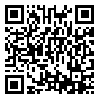Volume 18, Issue 41 (9-2022)
goljaam 2022, 18(41): 149-169 |
Back to browse issues page
Download citation:
BibTeX | RIS | EndNote | Medlars | ProCite | Reference Manager | RefWorks
Send citation to:



BibTeX | RIS | EndNote | Medlars | ProCite | Reference Manager | RefWorks
Send citation to:
Mousanejad ه. Investigating the role of peacock motif in Kerman carpets of the Safavid and Qajar periods. goljaam 2022; 18 (41) : 8
URL: http://goljaam.icsa.ir/article-1-867-en.html
URL: http://goljaam.icsa.ir/article-1-867-en.html
teacher
Abstract: (1076 Views)
The patterns used in Iranian arts were very common and widely used since the ancient time until now. Each of these patterns has conveyed a specidic meaning to the viewer. One of these motifs is the peacock. The motif of peacock is one of the most used symbolic motifs in the art of Iran and even the world. During the years, this motif has had a special place in the literature, art and beliefs of the Iranian people. This motif was present In Kerman carpets of the Safavid and Qajar period. The purpose and necessity of this research is to understand the role of the peacock motif in Kerman carpets of the Safavid and Qajar periods, and study some related features such as the appearance of the peacock, its location, number, direction, role, mythological elements. Such elements will be investigated and expressed, and the differences in the appearance and meaning of the peacock in the two mentioned periods would be compared. According to the mentioned cases, the main question of the research are as follows: 1) Did the visual form and semantic status of the peacock figure in Kerman rugs change from the Safavid period to the Qajar period, and did this change creat a difference between the visual form and semantic meaning of this figure? The research method is use of library materials and photo sources, images from reliable websites of carpet collectors, and the way of expressing the content is descriptive in the form of text, images and tables. 22 samples of carpets have been examined. The carpets were selected via a purposeful manner, all of them are related to the two special periods of Safavid and Qajar periods and the full presence of the motif of the peacock, has been considered in selecting them. 9 samples are related to the Safavid period and 13 samples are related to the Qajar period.The appearance of the peacock in the Safavid and Qajar periods has undergone some changes in comparison to each other. In the Safavid period, it is abstract and present in closed spaces, and in the Qajar period, the patterns are close to the natural state of the peacock that we see in nature and the peacocks are presented in freer spaces. But this free space has not affected the main role of the peacock, which protecting and guarding the heaven.
Article number: 8
Type of Study: Research |
Received: 2023/02/6 | Accepted: 2024/12/3 | Published: 2025/08/29
Received: 2023/02/6 | Accepted: 2024/12/3 | Published: 2025/08/29
Send email to the article author
| Rights and permissions | |
 |
This work is licensed under a Creative Commons Attribution-NonCommercial 4.0 International License. |





